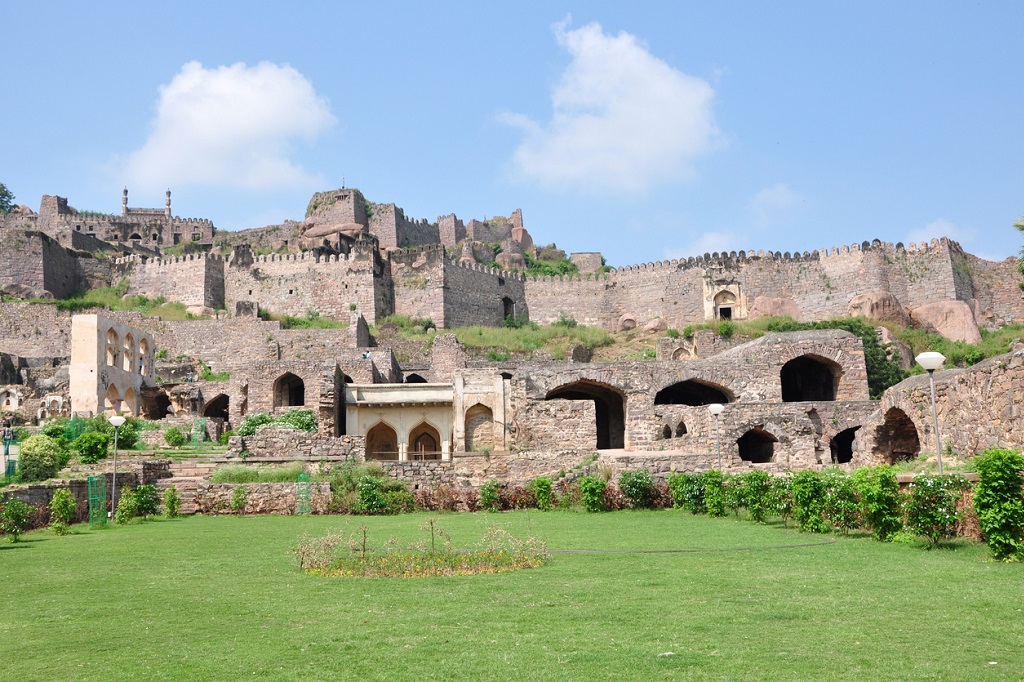Golconda is a fortified citadel and ruined city located in the western outskirts of Hyderabad, Telangana, India. The fort was originally built by Kakatiya ruler Pratāparudra in the 11th century out of mud walls. It was ceded to the Bahmani Kings by Deo Rai, Rajah of Warangal during the reign of Sultan Muhammad Shah (1358–1375 A.D.) of the Bahmani Sultanate. The name Golconda is thought to originate from Telugu for “Cowherd’s Hill.”
The abandoned Golconda Fort, currently in ruins was added to UNESCO’s “tentative list” in 2014 along with other sites in the area. Golconda Fort is listed as an archaeological treasure on the official “List of Monuments” prepared by the Archaeological Survey of India under The Ancient Monuments and Archaeological Sites and Remains Act.[14] Golconda consists of four distinct forts with a 10 km (6.2 mi) long outer wall with 87 semicircular bastions (some still mounted with cannons), eight gateways, and four drawbridges, with a number of royal apartments and halls, temples, mosques, magazines, stables,

Golconda used to be known as the ‘Diamond Capital of India,’ given the abundance of diamond mines. Out of the 38 diamond mines in the country, it is estimated that 23 are around Golconda Fort. It was believed that there was a hidden underground tunnel to the diamond mines. The mighty Koh-I-Noor diamond was stored in Golconda. Some of the most sought-after and well-known gems in the world, including Idol’s Eye, the Hope Diamond, Darya-i-noor, and the well-known Koo-i-noor, are known to have come from these mines.
History of Golconda Fort
The Golconda fort was known as ‘Mankal’. According to the data, the Golconda fort was initially a mud fort built by Pratāparudra of the Kakatiya Empire in the 11th century over the belief that a shephard boy who met an idol over the hilltop Golconda means “Cowherd’s Hill” in Telugu. The fort, built on a stone hilltop, was believed to defend the western region of the kingdom. Golconda was fortified and ruled by the Bahmani Sultans and then the ruling Qutub Shahi dynasty between the 14th and 17th centuries.
During the Bahamani Sultanate, Golconda slowly rose to prominence, and later in the early 17th century, Golconda established a prominent cotton-weaving industry. Cotton was manufactured in large quantities for both home and international use. Made from muslin and calico, a fine plain or patterned textile was created. There were two colours of plain cloth: white and brown, both bleached and dyed. These fabrics were exported to Europe and Persia. The prints used to create patterned textiles were created using natural dyes: indigo for blue, chay-root for red, and vegetable yellow. Exports of patterned textiles were mostly to Indonesia, Malaysia, and other eastern nations.
It was the Mughal emperor Aurangzeb who captured the final Golconda king, Abul Hassan Tana Shah, and forced the fort to collapse after an eight-month siege. The fort finally collapsed in 1687.
Geography at Golconda Fort
Golconda is made up of four separate forts with an outer wall that is 10 km (6.2 mi) long and has 87 semicircular bastions (some of which are still equipped with cannons), eight entrances, four drawbridges, and several royal chambers and apartments, as well as temples, mosques, depots, stables, and other structures inside.
The lowest wall is by “Fateh Darwaza” (known as the Victory Gate after Aurangzeb’s triumphant troop that entered the pathway). The walls are studded with enormous iron spikes to keep elephants from smashing them down.
Tales of Golconda
The story of the Koh-i-Noor travels from the Rajahs of Malwa, which subsequently went through the hands of several Indian kings, including the Mughal emperors, before being acquired by the British. The diamond was supposed to be so strong that owning it brought misfortune to its possessor and that it could topple entire kingdoms. There were rumours that the diamond was cursed and had the following inscription:
“He who owns this diamond will own the world, but he will also know all its misfortunes. Only God, or a woman, can wear it with impunity.”
Rumour has it that the fort is haunted by the king’s paramour. On the stage that was once hers, her ghost has been dancing. Even though there is no historical evidence to back up the stories of these curses, it is significant to remember that many of the owners of these diamonds were also prominent figures.
Things to do at Golconda
The visiting times at Golconda are from 9:00 a.m. to 5:00 p.m.
Fateh Darwazaan (acoustic property): The ‘Bala Hisar’ pavilion, which is the highest point over a kilometre distant, is the place where one can clearly hear the reverberating handclap that occurs at a certain location beneath the dome at the entrance of ‘Fateh Darwazaan’’. This served as a warning in the event of an assault.
Water and ventilation systems: The fort’s water supply system has been cleverly constructed. Above-ground tanks hold varying volumes of water that are elevated by Persian wheels. The collected water is then employed by gravity to transport it throughout the citadel’s structure of stone aqueducts and earthen pipes to other mahals, other apartments, roof gardens, and fountains.
City view: The eight entrances lead to a fortress complex exquisitely designed with lush, green gardens set against the striking brown of the citadel walls. Witness the symmetry of the temples, troop barracks, royal apartments, stables, and courts. The twin cities of Secunderabad and Hyderabad, the Kala Mandir arbores of Premamathi Nritya Mandir and Taramathi Gana Mandir, and the thousand-step stairway up to the durbar hall are also visible from above.
Light and sound show: Every evening, a captivating light and sound display that portrays this magnificent fort’s illustrious past is presented to help you understand more about its history.
Nearby attractions include:
Walk through the famous ‘Charminar’
Tour at ‘Chowmahalla Palace’
Birla Mandir
